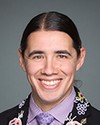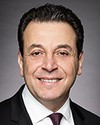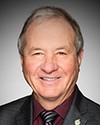Thank you all.
Mr. Ouellette, four minutes.
Evidence of meeting #15 for Finance in the 42nd Parliament, 1st session. (The original version is on Parliament’s site, as are the minutes.) The winning word was economy.
A video is available from Parliament.
Liberal

Robert-Falcon Ouellette Liberal Winnipeg Centre, MB
Thank you, Mr. Chair.
I'd like to know what the impacts of high or low federal debt on economic growth are, and what factors the federal government should consider in determining an appropriate for the federal debt-to-GDP ratio?
Assistant Parliamentary Budget Officer, Office of the Parliamentary Budget Officer, Library of Parliament
There is no optimal level of federal debt-to-GDP ratio. It's something that's hard to determine, and it depends on the situation and circumstances. There are some estimates out there. Some people are talking about 80% or 60%, but it's not determined what the optimal rate is. That's not something we are focusing on in our reports. What we look at normally is whether the GDP ratio is stable or whether it's declining, which sort of determines whether the fiscal structure is sustainable or not.
Liberal

Robert-Falcon Ouellette Liberal Winnipeg Centre, MB
What would be the impact of extreme poverty in Canada on economic growth?
Assistant Parliamentary Budget Officer, Office of the Parliamentary Budget Officer, Library of Parliament
That is not something we have looked at unfortunately, the impact of poverty on economic growth.
Liberal

Robert-Falcon Ouellette Liberal Winnipeg Centre, MB
Is that something that should be taken into account?
Assistant Parliamentary Budget Officer, Office of the Parliamentary Budget Officer, Library of Parliament
I think what we are doing typically is looking at the economic conditions and doing our projection, but we are not looking at a specific part of the population and how that would affect overall growth in the Canadian economy. Certainly there are impacts of poverty and people cannot spend money, but it's not something we have looked at.
Liberal

Robert-Falcon Ouellette Liberal Winnipeg Centre, MB
From what I understand, you were looking at things from a uni-directional or uni-dimensional regard, or looking at the whole issue surrounding economic growth in the budget?
Assistant Parliamentary Budget Officer, Office of the Parliamentary Budget Officer, Library of Parliament
Our real interest at the end is the budgetary matters. To do fiscal projection, and to see how the fiscal situation is evolving, we need to have a view of the overall macroeconomic conditions and development, and that's what we focus on. A detailed micro-analysis of the different groups and different income groups in terms of how they're going to affect the economic growth is not something we have done. It would be interesting to do, but that's not something we have done.
Liberal

Robert-Falcon Ouellette Liberal Winnipeg Centre, MB
It could be conceivable, for instance, if we had more investment in trying to eradicate a lot of the extreme poverty that exists in Canada, especially among children. The long-term benefits to economic growth might come about that might see a long-term increase in the economic potential of Canada, and eventually all Canadians.
Assistant Parliamentary Budget Officer, Office of the Parliamentary Budget Officer, Library of Parliament
As I said, certainly, those are all possibilities, that investment in education, investment in health, and investment in children may eventually add to productivity and economic activity, but those are for general principles, yes.
Liberal

Robert-Falcon Ouellette Liberal Winnipeg Centre, MB
Okay, thank you very much, and I'd just like to share a bit of time with the parliamentary secretary.
Liberal

The Chair Liberal Wayne Easter
We'll have time to come back to him.
I'll go to Mr. Aboultaif and then we'll come to Mr. Champagne. That way you will have a little more time.
Conservative

Ziad Aboultaif Conservative Edmonton Manning, AB
Thank you, again. The question is how do we identify middle class in Canada in terms of income structure and in terms of the overall Canadian economy. Can you advise us the percentage of Canadians who could be considered as middle class?
Assistant Parliamentary Budget Officer, Office of the Parliamentary Budget Officer, Library of Parliament
The definition of middle class really is a political definition, not a mathematical or economic definition. Depending on what ranges of income you decide, what level of wealth, people have different views of the middle class. There is really no one definition of middle class. I mean it's not something that we focus on, deciding exactly what the middle class is, which income level. That could vary in different circumstances. Unfortunately, I cannot advise you on what the middle class is.
Conservative

Ron Liepert Conservative Calgary Signal Hill, AB
In the modelling that you would do fiscally, I'm presuming there's a time frame that you would like to use for a new program whereby there's kind of a maximum take-up on it, if you will. The TFSAs are a relatively new program, about seven or eight years or something like that. In your estimation what time frame would you need to really assess whether people are aware and have the ability and are maximizing their ability to contribute? What would be an estimate that you might say would be fair?
Assistant Parliamentary Budget Officer, Office of the Parliamentary Budget Officer, Library of Parliament
It's very hard to really put a time limit on this, but the fact of the matter is that with any kind of program like the TFSA, which essentially is a savings program, over time as that limit of savings increases, it's a reality that people who have higher income and higher wealth can benefit more from that program. It's much harder for an individual with a $50,000 income to find $10,000 savings every year than for somebody who is making $200,000 a year. So yes, in the beginning of a TFSA program, people move their assets from what they have already saved into a TFSA to take advantage of the interest-free return, but over time it becomes more and more difficult for those people and the benefits will go to higher-income people. But exactly what time frame will show that, I cannot say, unfortunately.
Conservative

Ron Liepert Conservative Calgary Signal Hill, AB
I would like to, on that same modelling, get your opinion on this. One of the criticisms, or one of the reasons for ratcheting back the decision to increase the maximum was that people were not contributing to their maximums. Would you say, given the short time frame that it was there, that it wasn't given a fair assessment?
Assistant Parliamentary Budget Officer, Office of the Parliamentary Budget Officer, Library of Parliament
What we have seen is that, after 2013, 18% of people who had a TFSA had maximized their contribution. What has happened since then, we don't have that information, so we can't really tell. As I mentioned, in principle, as we move on, that percentage probably is going to drop because fewer and fewer people will have the capacity and the financial resources to benefit from the maximum amount of TFSA.
Liberal

François-Philippe Champagne Liberal Saint-Maurice—Champlain, QC
Thank you, Mr. Chair.
Mr. Askari, please refresh my memory. I think that only 6.7% of Canadians contributed the maximum cumulative amount of $41,000 to a TFSA.
Could you confirm that this is indeed the case?
Director, Economic and Fiscal Analysis, Office of the Parliamentary Budget Officer, Library of Parliament
No, I believe that statistic, although technically correct, actually includes a base of all Canadians including those who haven't actually opened TFSAs. When you look at the individual Canadians who have opened TFSAs, the statistic from the Canada Revenue Agency as of 2013 was closer to 18%.
Liberal

François-Philippe Champagne Liberal Saint-Maurice—Champlain, QC
However, 6.7% is still a valid point of reference; you just disagree with the premise, but it is a valid statistic, as we look at it. You might, then, agree that we have decided to do things differently to cover more people.
Mr. Fréchette, the tax measures we announced regarding tax cuts for the middle class affect about nine million Canadians, if I'm not mistaken. Do your figures show the number of Canadians who will benefit from the positive impact of the tax cut for the middle class?
Parliamentary Budget Officer, Library of Parliament
We did not do that calculation.
As we said before, we certainly did not determine what the middle class is either. Since we did not define the middle class in our reports, we did not come up with that figure.